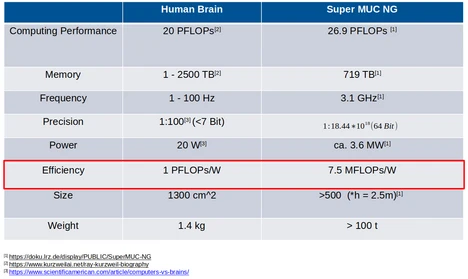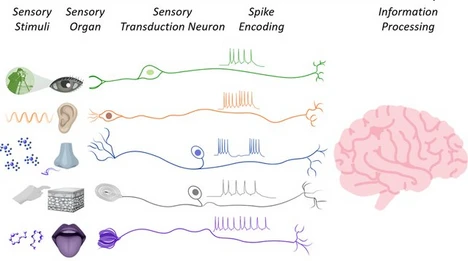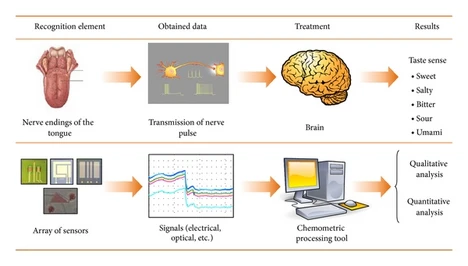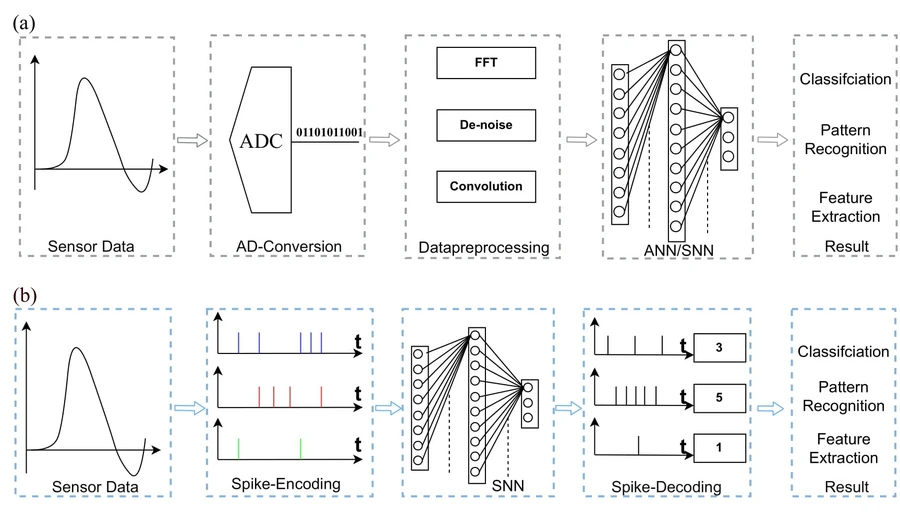Neuromorphic Hardware

Research activities in the context of artificial intelligence (AI), especially on Artificial Neural Networks (ANN) and its applications has drastically increased in the last few years. Improvements in the development of Convolutional Neural Networks (CNN) reduced the error rate of image classifications below the ability of the human brain [1]. These neural nets have up to 167 layers with more than one hundred neurons in one layer. Because of their highly parallel architecture, they use GPUs instead of CPUs for calculating the weights and results of the network nodes. Still, they consume a huge amount of energy between 0.77 and 1.47 MJ [2] for such calculations, which translates to a power consumption of more than 100kW (this is equivalent to a small power plant!). This is mostly due to the so called von-Neumann-Bottleneck which describes the data-movement between memory and processing element [3] In comparison the human brain consumes only 20W being able to solve a variety of different tasks. Furthermore digital calculation of results in silicon is not seeing much improvements in recent years as Moore´s law seems to come to an end.

In Figure 1 a comparison between the human brain and the Super MUC NG which is located in Garching is made. Even if the metrics are not really fair, one can easily see the big gap in energy efficiency. Also the flexibility and size shows huge advantages. Our goal at LSE is to build neural networks in a much more energy-efficient way. Mimicking the human sensor systems (e.g. nose, tongue, skin) these sensors are rather imprecise in their output signals. Figure 2 shows the main human sensory system, including eyes (vision), ear (sound), nose (smell), skin (pressure, temperature) and the tongue (taste). Continuing our comparison to nature, we build our circuits based on the concept of Spiking Neural Networks (SNNs) using memory elements as synapses and an additive threshold detector as neuron such systems promise to be less power-hungry than their predecessor artificial neural networks (ANNs).

Let’s take the human tongue as an example: We can detect sweetness, sourness, temperature pretty good, but the resolution of how sweet it is rather low (which is very contrary to digital sensor systems with often >10bit resolution). Like the human nervous system/brain uses the correlation of all the sensor signals to categorize the most important information: Does it taste “good” or “bad”, is it hot (so we don´t burn ourselves) or is it even poisonous (dangerous) we can copy also this concept here for circuit design and build a reconfigurable and adaptive information processing system.
In the system context of smart sensors for decentralized information gathering – which means that only the relevant parts of sensor information are transferred we are able to save a lot of resources, bandwidth and energy.
The energy problem for neural networks can be divided into two main operations:
Inference: Feed-forward propagation of the signals through the network with a prediction at the output
Learning: Fitting the weights of the network to minimize the loss of the predictions.
Most systems focus on the inference with a pre-trained network (offline-learning), which often use the backpropagation algorithm for learning, others also build neuromorphic HW which can execute online-learning. While starting at a similar concept, LSE also plans to build analog HW which can execute unsupervised learning on chip.
Figure 4 shows the application for a conventional and proposed sensor system. The proposed biologically inspired system can directly encode the analog input sensor signals and feed those to an SNN, where the interpretation of the sensor data is done directly with low latency and energy. Energy-consuming A/D Conversion at the sensor can be skipped. Also, our biologicalinspired approach minimizes energy consumption by avoiding unnecessary data movement of weight and activation data as in digital implementations.
Reference
He, K., et al. Deep residual learning for image recognition. in Proceedings of the IEEE conference on computer vision and pattern recognition. 2016.
Castro, F.M., et al., Energy‐based tuning of convolutional neural networks on multi‐GPUs. Concurrency and Computation: Practice and Experience, 2019. 31(21): p. e4786.
Sze, V., et al., Efficient processing of deep neural networks: A tutorial and survey. Proceedings of the IEEE, 2017. 105(12): p. 2295-2329.
Subbulakshmi Radhakrishnan, Shiva, et al. "A biomimetic neural encoder for spiking neural network." Nature communications 12.1 (2021): 1-10.
Gutiérrez-Capitán, Manuel, et al. "Hybrid electronic tongues applied to the quality control of wines." Journal of Sensors 2014 (2014).
M. Ochs, M. Dietl and R. Brederlow, "A Circuit Concept for Energy-Efficient Spiking Neural Network Systems with a FOM of 86.9fJ/SOP," 2024 IEEE Biomedical Circuits and Systems Conference (BioCAS), Xi'an, China, 2024, pp. 1-5.
